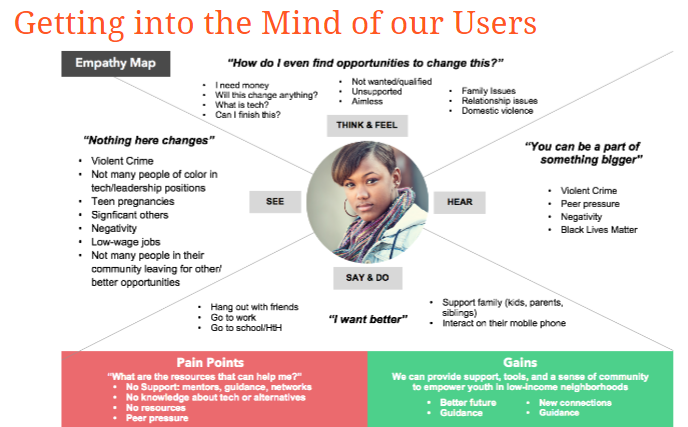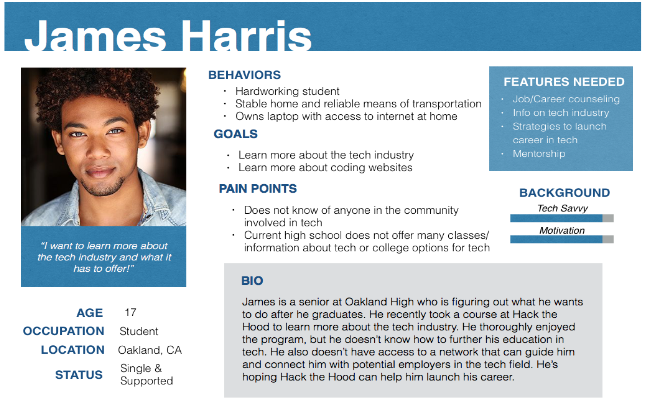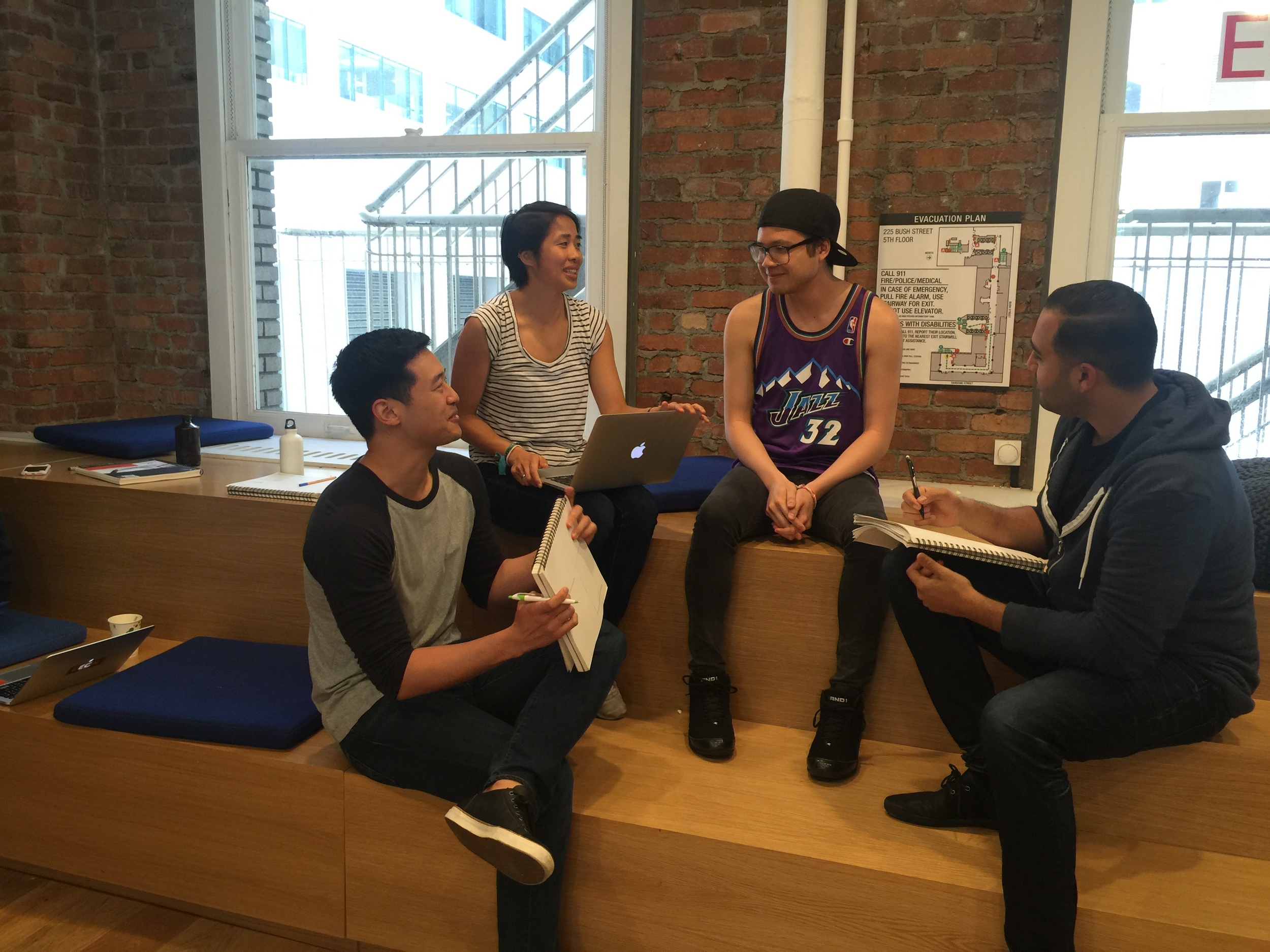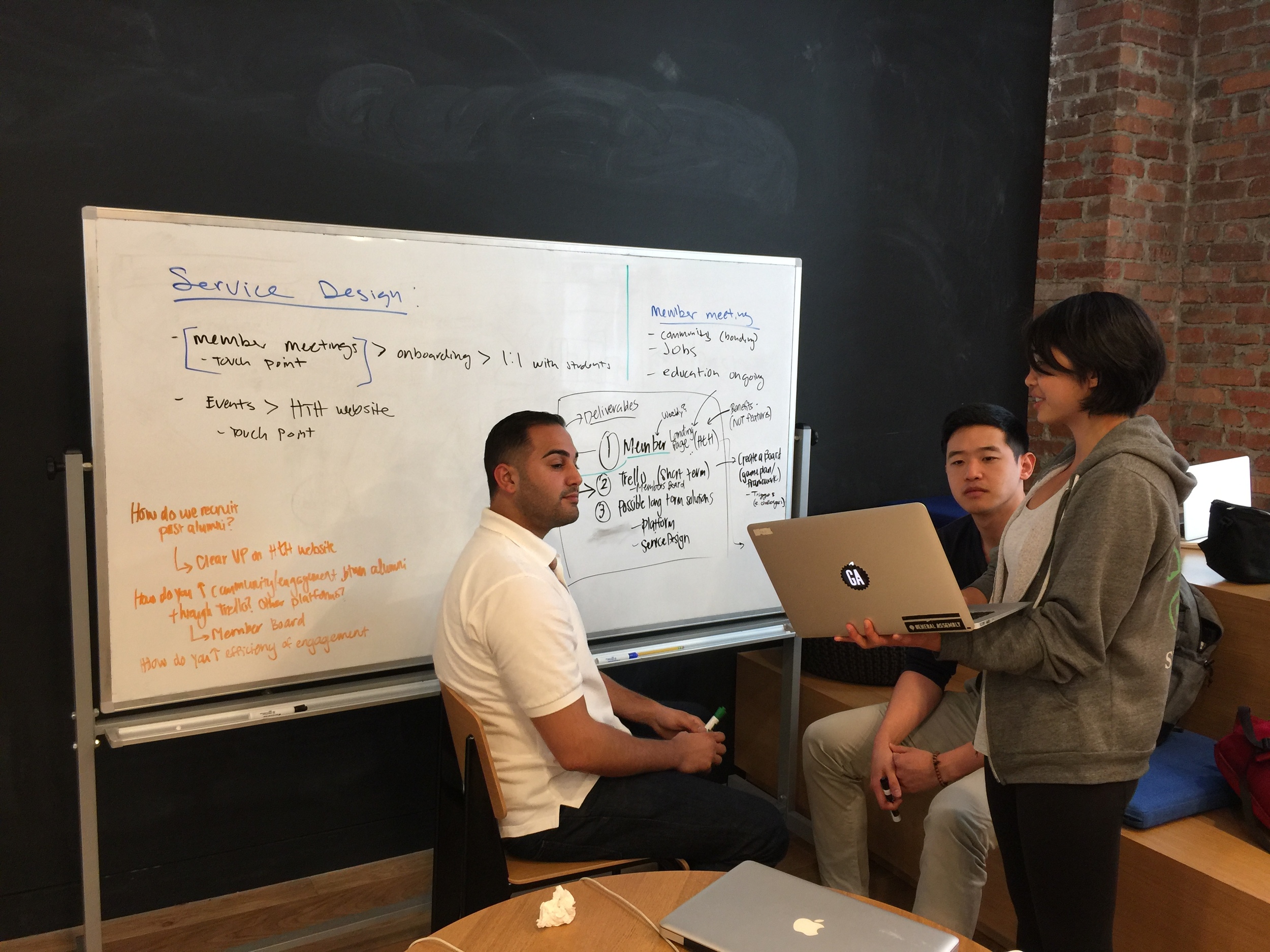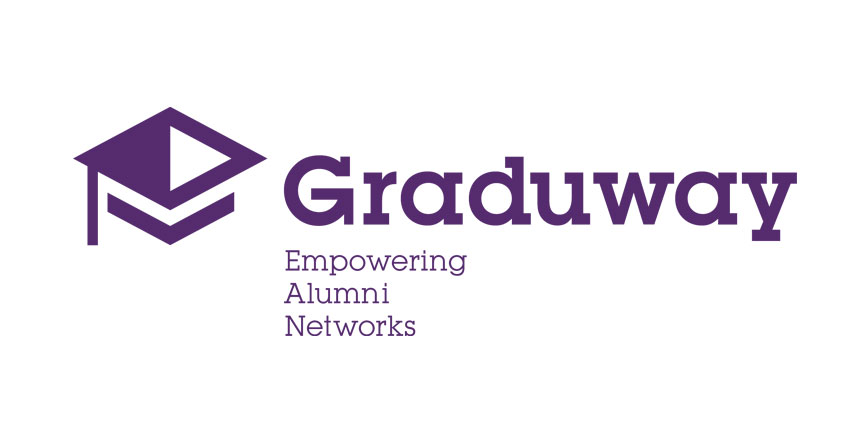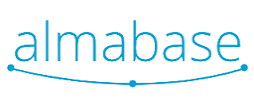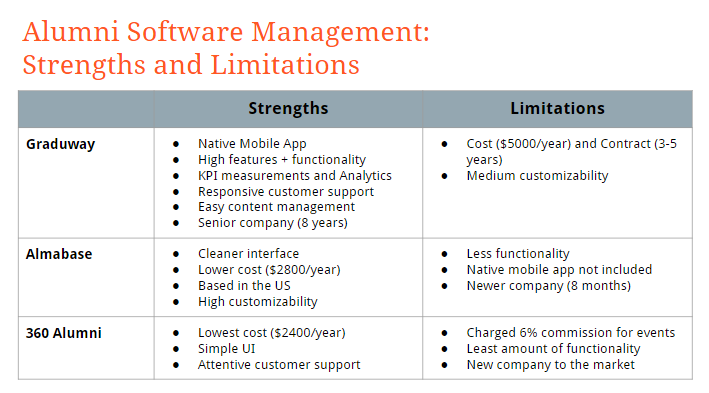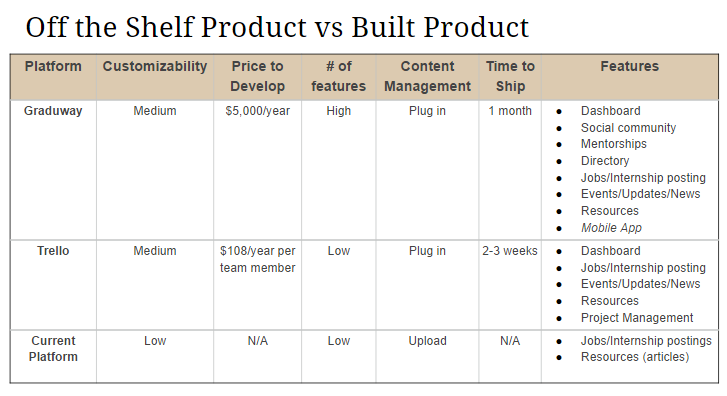OVERVIEW
Hack the Hood is an Oakland-based nonprofit empowering underprivileged youth with 6-week tech "bootcamps". However, the organization struggles with maintaining relationships with the students after the bootcamp ends. The clients wanted to build a digital product that would be able to address all of the alumni needs in one consolidated platform
ROLE & DURATION
I was on a team of three UX Designers. My role was to conduct research, analyze data, create an empathy map, ideate solutions, wireframe and prototype, and design a comprehensive service design plan for Hack the Hood.
Duration: 14 days.
TOOLS & METHODS
- Design Strategy and Concept Design
- Surveys + User Interviews
- Competitive/Comparative Analysis
- User Personas + Empathy Map
- Wireframe + Prototyping
- Usability Walkthroughs + Tests
- Client Management
- Service Design
- Tools: Sketch, Invision, Wix, Paper + Pen, GoogleForms
the problem
"I don't feel like Hack the Hood can help me after I graduate from the bootcamp."
-Hack the hood alumni
One of the biggest challenges facing Hack the Hood is that many alumni no longer felt like they could lean on the organization after the bootcamp. Because of this, there were very low levels of engagement, especially when it came to monthly workshops or lectures that the organization hosted for alumni.
the solution overview
Creating a sense of community from day one.
After extensive research, it was clear that a single digital product, like an alumni portal, would not be the right solution. Instead, focusing on a more holistic solution that emphasized more service design than digital would be a much more impactful, scalable, and economical option for Hack the Hood.
the obstacles
Who are the users we are truly designing for?
defining THE TARGET USER
In order to properly design a user-based solution, it was important to first properly define and understand the target user, particularly their goals, needs, pain points, and daily environment. This was a big challenge for my group since our target user was underprivileged youth in the Oakland community. Access to the target demographic for surveys or interviews were limited, proving to be a large challenge for my team.
To learn more about our user, we reached out to subject matter experts and leaders in the same space, including The Posse Foundation, College Track, and Dropbox. These interviews allowed us to understand (1) the challenges for youth from low-income communities and (2) how these organizations managed and maintained connections with youth who have already left their programs.
Understanding the organization's constraints
As a nonprofit, Hack the Hood faces many unique constraints, including limited staff capacity, limited resources and funding, and a lack of time to implement any solutions before their upcoming summer bootcamp. It was important to constantly assess any ideas, designs, and solutions within the context of these constraints.
Navigating between multiple stakeholders at the organization
There were multiple stakeholders at the organization with different ideas on the direction of the alumni program. Managing the client and working across multiple departments within the organization was a challenge, especially since these departments did not communicate with one another. However, I proposed holding a design studio session with all stakeholders. This session allowed everyone to provide their own input and feedback, but also helped get everyone on the same page moving forward.
the RESEARCH + KEY INSIGHTS
How do we build community?
For the first 9 days, I conducted surveys, user interviews, and stakeholder interviews. My team also conducted a competitive & comparative analysis, as well as interviews with Subject Matter Experts (SMEs).
the 5 Key Insights:
Mentorships: You can smell a bad one a mile away.
- From the interviews with alumni, it was clear that many students felt that the mentors they were assigned were not actually deeply invested. This lack of support also led to a disenchantment, ultimately leaving many students unwilling to engage with Hack the Hood upon graduation.
- Curriculum: One size does not fit all.
- Interviews also revealed that many students were frustrated that the curriculum was too broad. They wanted the opportunity for deeper dives into the hard skills, or the chance to learn about certain coding languages.
- Community: The alumni need support, even after the bootcamp.
- Data from surveys and in-person interviews revealed that alumni did not feel like there was any sense of community or any emphasis to stay in touch with each other. Additionally, there was no accessible way to contact each other for resources.
- Resources: The learning never stops. Ever.
- SME interviews revealed that students need resources to further their education and discover more opportunities post-graduation.
- Alumni Offerings: Don't over-promise and under-deliver.
- Again, another key insight pulled from the surveys and interviews were that many students felt like the workshops and meetings for alumni were falsely marketed. Alumni would come expecting a deep dive into CSS and walk away having barely scratched the surface.
From here, I was able to better understand our users, as well as their wants, needs, and pain points. I then created the following empathy maps and user personas:
the design strategy
Don't build a product that no one will use.
After multiple interviews with stakeholders, users (alumni), subject matter experts, and similar organizations, I learned that a single digital product, like an alumni portal, would not be the right solution. Given the nonprofit's resource constraints and timeline, it would not have been possible to build a product in time for the upcoming Summer 2016 program.
In addition, throughout all my conversations with the alumni, it was clear that the true opportunities were within the multiple touchpoints the organization had with each youth throughout the bootcamp. Because of this, it was crucial to consider any solutions within a service design framework, emphasizing improvements within the programming over stand-alone digital solutions.
Images of my team and I interviewing users and alumni, as well as brainstorming our service design ideas.
deliverables
Comprehensive, Holistic, Impactful.
Alumni program landing page
This landing page would live on the current Hack the Hood website and serves to drive current bootcamp graduates to re-engage with Hack the Hood's alumni program.
I created the paper sketches, wireframes, and UI design for this landing page. My team then conducted several usability tests throughout each phase, using the feedback to inform our design decisions:
To see the full site preview, please click here.
short term solution: trello
Trello is a fantastic tool for case management as alumni work towards their goals post-bootcamp. Additionally, Trello's business class is affordable and within Hack the Hood's budget.
In addition to the current functionality of software, my team researched other plug-ins or "power ups" that Hack the Hood could utilize to strategically increase their capacity on Trello. The following five are the most useful and high impact plug-ins that my team recommended for Hack the Hood:
While Trello is a fantastic case management system for staff-to-student relationships, it was severely lacking in its capacity to foster student-to-student relationships. Because of this, my team strongly recommended Trello only as a short-term solution.
Long Term Solution: Alumni Management software
Despite Trello's strengths, we did see many limitations regarding scalability and scope. Therefore, third party alumni management systems— such as Graduway, Almabase, or 360 Alumni— offering customizable, built-out landing pages are a great long-term solution for Hack the Hood.
Of the many third party softwares out there, Graduway, Almabase, and 360 Alumni were the top three products that fit Hack the Hood's goals and constraints. Of these three, my team recommended Graduway due to its many features, including the ability to foster community within students and the ease of finding suitable mentors for each student.
I created the following pros & cons charts to demonstrate the benefits and weaknesses of each product:
Service design: families, youth leadership board, outcomes programming
it is important to note that all these digital tools and products cannot exist in a vacuum. In order to move Hack the Hood's mission forward, several services and programs needed to be re-designed. I proposed the following solutions:
families
Purpose: Create smaller groups of accountability and community for students to feel supported by facilitating camaraderie, mentorship, and community within these micro groups.
Led by alumni mentors
Groups of 5-7 students
Introduced on Day 1 of the bootcamp
youth leadership board
Purpose: Create an outlet for alumni to meaningfully contribute back to
Hack the Hood, allowing those who have already graduated to design for those who are currently in the pipeline.
- 5-6 highly active members
- Leads the alumni programming and mediates between alumni and organization
- Creates and manages content
outcomes Programming
Purpose: Demonstrate that Hack the Hood also cares about life post-bootcamp and is prepared to give students the resources, guidance, and tools that they need.
- Weekly, in-class, and mandatory
- Focuses on addressing the true students' needs, questions,
and concerns about life post-bootcamp
All three of these service design solutions serve to strengthen the feeling of belonging to the Hack the Hood community. When students feel a greater sense of belonging, they are much more likely to continue engagement with the organization.
From day 1 students should know and feel that they are now a part of the Hack the Hood family, for the next 6 weeks and beyond.
result & reflection
Follow the user and design for them (within your constraints).
Originally, the brief was to create a digital product or alumni portal for the graduates of the Hack the Hood bootcamp. While building a highly customized alumni portal or fun mobile app to engage the kids could be a good solution, it wasn't a great one. For one, it was not within Hack the Hood's resources or technological constraints to be a viable possibility. Second, our research showed that it did not address what the graduates truly needed.
So what did the graduates truly need? All the research pointed to one thing: Community.
From here, all design decisions were based in the need to create support, safety, and a sense of community for the at-risk youth graduating from Hack the Hood's bootcamp. The question evolved from "How do we get graduates to engage with us online?" to "How do we make Hack the Hood have true value to the students, even post-bootcamp?"
By moving our focus to life of each youth before, during, and after Hack the Hood's bootcamp, we could design a solution that is not only holistic, but also directly addresses what the youth truly needed. For that reason, our solution included four major areas of improvement for Hack the Hood: An improved landing page, Trello power-ups, service redesign suggestions, and a recommendation for alumni management softwares as a long-term solution.


